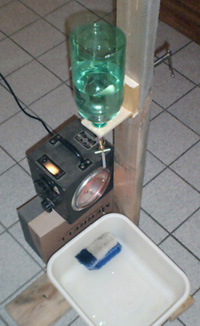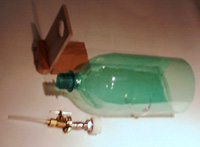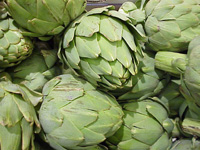 |
 | ||||||||||||
|
|||||||||||||
Fibonacci numbers
We talked about Fibonacci, and his numbers. Fibonacci (meaning son of Bonacci), also known as Leonardo of Pisa, was born in 1175. During business trips around North Africa and the Middle East he picked up mathematical knowledge from Islamic traditions. Most importantly, he introduced to Europe the modern place-value decimal number system, using the arabic numerals 1-9, plus the all-important 0. Try doing long division in Roman numerals! Leonardo is of course most famous for his number series 1,1,2,3,5,8,13,21,34,55,... where each number is the sum of the preceeding two. These numbers show up in many places around us, and I had brought in several of them: a collection of pinecones from the neighborhood, a cauliflower, a broccoliflower (a cross between cauliflower and broccoli), an artichoke, and asperagus. With big red and green markers I showed how to count the spirals going clockwise and counterclockwise. We found 5 and 8 on some of the pinecones, and 8 and 13 in others. I found artichokes the best for demo's, since they are big and you can draw the spirals on them with big markers. It is harder to do on most pinecones. The 5 and 8 spirals also could be found in the cauliflower and the broccoliflower, but in the very center of the broccoliflower was an 8-and-13 pattern - a nice surprise [in recent years, I haven't been able to find broccoliflower in the stores anymore]. I left the pineapple as a 'homework assignment'. The cauliflower, by the way, was also a good example of a fractal structure found in nature: the structure of the whole cauliflower is reproduced in miniature in the fleurets that make up the whole cauliflower, and again in parts that make up a fleuret. The Fibonacci series leads to the 'Golden Ratio' (see the links below), and this ratio shows up everywhere, if you are looking for it. However, it is not clear in many cases if this is purely accidental, or intentional.
Links about Fibonacci and related subjects:
|
|||||||||||||


What gives raindrops their shape?
As usual, I asked the kids what they thought raindrops were shaped like, and I got the whole range of guesses, from spheres to flattened shapes, donuts, teardrop shapes and upside-down teardrops. Nothing beats a good demo, so to show the actual shape of a falling water drop, I made a dripper and illuminated the falling stream of drops drops with a strobe light. The dripper was made from a 2-liter bottle with the bottom cut off. In the cap I cut a hole and mounted a tire valve (the kind that mounts with a nut, with the innards taken out). In the hardware store I had found this tiny brass valve, and the pieces connected with a few inches of plastic hose and a hose clamp. The last piece of hose that the water drips out of is 1/8" ID. I made a small L-shaped holder out of wood which is captured between the bottle and the cap. The base is a scrap of 2x6 with a 2x4 riser attached and a c-clamp secures the bottle-holder to the 2x4. The upside-down brush prevents splattering. The strobe I borrowed from a friend. It is an ancient neon strobelight, which can be set to flash at rates from a few Herz to 10 000 Hertz. I set it to flash so fast that it looked like a steady orange-red light - I didn't want to cause any headaches or seizures. Then I set the bottle dripping and we all looked at the shape of the drops. When the water is flowing slowly so that big (3-4mm) drops form at the end of the straw, and then break off, the drops initially looked a little out-of-round, like misshapen jellybeans. About 2 feet lower down, they were pretty much spherical, perhaps a bit flattened. If you increase the flow such that a solid stream of water comes out of the end, and breaks up a few inches lower, all kinds of things can be observed. The most striking is that the drops no longer just fall straight down but little drops get scattered all over the place. After staring at this for a while, we could see the reason: when the stream of water starts falling, it gets thinner as the water falls faster. Eventually the stream becomes too thin and breaks. The upper part of the string 'pulls up' and forms a bead of water connected to the end of the stream. This happens so fast that this bead actually travels upwards, and collides with descending water. This causes the sideways splattering. An unexpected and interesting effect, which the kids could figure out just by looking. Apparently when the drops are big and fall faster than can be achieved in a few feet, they flatten out dramatically, and turn almost into donuts before they become unstable and break up. Check out the links below.
Links:
|
|||||||||||||
| |||||||||||||


